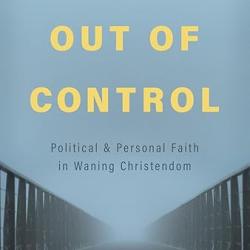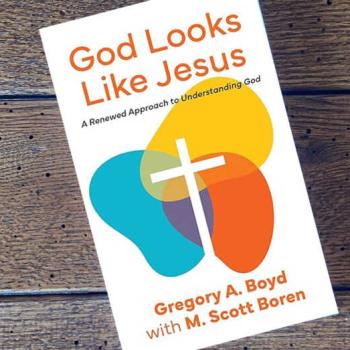The Way We Were
I realize nostalgia is not for everyone; I’ve always been a nostalgic person. I’m one of those people who walks up to your front door and says “I grew up in this house. Would you mind if I came in and looked around? I want to refresh my memory because I think about it a lot and some of the rooms are getting quite fuzzy in my memory.” You feel like slamming the door in my face, right? So I don’t do that. But I am tempted to it when I’m in a town where we lived when I was a child or teenager.
I’ve explained here several times why I can’t give up calling myself an evangelical. I won’t go back over that again except to say it’s part of my identity.
One instrument of forming that identity was a magazine called Eternity. I’ve mentioned it here before, too. I don’t remember exactly when I first began reading it, but it was sometime around 1973. Then I read it religiously until it stopped publishing sometime, I think, in the 1980s.
Eternity played a huge role in my theological development out of extremely sectarian Pentecostalism and fundamentalism into the larger, broader evangelical world. It was articles and book reviews and even advertisements in Eternity that intrigued me and caused me to look beyond my limited horizons and even beyond “normal” evangelical horizons. Eternity published articles by non-evangelicals such as Helmut Thielicke and reviews of books by non-evangelicals such as Hans Kueng. (I picked those names just because I saw an article by the former and a review of a book by the latter in a bound volume of Eternity from 1973 that I own.)
I own three bound volumes of Eternity—1973, 1974 and 1975, volumes 24, 25 and 26. Which tells me it began publication in about 1949. It evolved out of an earlier magazine called Revelation which was founded by Donald Grey Barnhouse in 1931. Eternity was published by The Evangelical Foundation headquartered in Philadelphia and somehow affiliated with Tenth Presbyterian Church which Barnhouse pastored for many years. Barnhouse was a well-known and influential fundamentalist-turned-neo-evangelical Bible teacher who had a radio program and wrote numerous books and commentaries. (He was somewhat unusual in being both Reformed and dispensational.) His successor as pastor and Bible teacher (on the radio program) was James Montgomery Boice (1938-2000)—a pastor and theologian who studied with Karl Barth in Basel. Boice was my homiletics professor in seminary; I still have three written sermons I wrote for him. He seemed to like them. (Boice took a sabbatical from his pulpit and the radio program in 1976 to teach a “January term” at North American Baptist Seminary. It was there that I studied under him.)
Boice eventually became publisher of Eternity and then suspended it. For me that was a black day (or month). I was sad to see it go as it had served as one of my main avenues of socialization into evangelicalism. I do not know this for sure, I am speculating, but I suspect the Evangelical Foundation somehow or other turned into the Alliance of Confessing Evangelicals and that, in some sense, Modern Reformation is Eternity’s successor publication. I know that Boice was an early leader in the Alliance and I’ve always wondered where the money for Modern Reformation came from. Perhaps from The Evangelical Foundation? I’d be glad to know. I can’t find anything about the latter on the internet.
So what do I mean by Eternity representing “the way we were?” Eternity was by all accounts a mainstream evangelical publication; it leaned neither to the “right” nor the “left” although it published articles by evangelicals who “leaned.” Most of its regular contributors and editors, however, were middle-of-the-road evangelicals. If it had any agenda or editorial mission it was to serve as an instrument for expression of mainstream evangelical views.
As I’ve said many times before here, something happened within American evangelicalism around 1978. That was the year I graduated from seminary. That was also the year Harold Lindsell’s truly awful book The Battle for the Bible, about inerrancy, was published. I saw its effects close up. Suddenly, my mainstream, middle-of-the-road evangelical seminary was forced to adopt an inerrancy statement and professors who had been hired without any such expectation were forced to sign it or leave. I witnessed professors who had taught against inerrancy in classes sign the statement to keep their jobs. One refused and left. This happened all over the country.
Within just a couple of years the whole atmosphere of evangelicalism changed. Suddenly fundamentalism was rearing its ugly head within the ranks of mainstream “neo-evangelicalism” and in the Southern Baptist Convention. I went directly from North American Baptist Seminary to Rice University to study with Southern Baptist theologian John Newport who had taught at Southwestern Baptist Theological Seminary and then, after I arrived, left Rice to go back to SWBTS as its provost.
The year was 1979. I sat in seminars with Newport as he reported to us blow-by-blow the “fundamentalist take over” of the Southern Baptist Convention. The Convention’s annual convention was meeting in Houston just a couple miles from the room where we met with Newport for seminars. He was attending the convention and pastors conference. He was dismayed by what he was hearing—that allegedly there were “liberals” teaching in the SBC seminaries! He had been one of them (according to some of his critics) because he wrote a book (co-authored with William Cannon) entitled Why Christians Fight over the Bible in which he denied strict inerrancy. Anyone who knew John, however, knew he was anything but “liberal.” If there ever was a God-fearing, Jesus-loving, Bible-believing Christian scholar, philosopher and theologian, it was John Newport.
Back to Eternity.
When I look back at those three bound volumes of Eternity what strikes me is the irenic approach the editors and authors took to issues. And how progressive and courageous many of the articles were—in confronting fundamentalism. For example, the January 1973 issue contains and article by a professor at Calvin College and his wife entitled “Was Paul a Woman-Hater?” The carefully crafted and biblically defended answer is “no” and the authors go so far as to argue that Junia was a female apostle. The implications are clear: they (the authors) believed in equality of women with men in ministry. The article purported to be a critique of feminists’ dismissals of Paul as a woman-hater, but, in fact, it was also a critique of conservative evangelicals’ dismissal of women as unworthy to be ministers.
Also in the January, 1973 issue of Eternity was a very well-written and insightful review of several movies (e.g., Straw Dogs starring Dustin Hoffman) entitled “Does Violence Have a Place?” by Karen R. DeVos. Her answer is yes—but not in the way Hollywood presents it. She complains that too many movies glorify violence as an initiation into true manhood.
The February, 1973 issue contains an article by Lewis K. Glanville entitled “How to Succeed as a Middle-Class Christian.” The title, like many Eternity article titles, is ironic. The thrust of the article is anti-middle class values and pro-social justice.
The same issue contains a book review of two books by Rudolf Bultmann by Nancy B. Barcus. While she is mainly negative toward Bultmann’s demythologizing hermeneutic, she points out positive contributions as well. Like most Eternity book reviews, it looks for the light even in unexpected places and advocates that evangelicals read scholars like Bultmann discerningly. (In contrast to fundamentalism that would usually forbid reading the likes of Bultmann!)
The March, 1973 issue contains a review of David Moberg’s The Great Reversal by Ronald Enroth. Enroth strongly commends the book for telling the story of evangelicalism’s abdication of social responsibility between the early 19th and early 20th centuries.
Many articles in Eternity during the 1970s promoted evangelical social action that today would be labeled “liberal.”
The April issue contains a ringing call for irenic evangelical relationships in spite of serious disagreements over secondary doctrinal matters by Vernon Grounds, president of Denver Conservative Baptist Seminary (now Denver Seminary). The article’s title is “How to Keep the Peace.” Grounds concluded “As Christians concerned about keeping a genuine and permanent peace among ourselves, we must labor together according to these principles. There is no reason in the world why our charity, harmony and unity should not compel the reluctant tribute even of unbelievers , ‘Behold, how these evangelicals love one another’.” (p. 38)
How terribly that advice was ignored in the coming decades as evangelicals began to devour each other over different views about the Bible, politics, women, predestination, God’s foreknowledge, the salvation of the unevangelized, postmodernity, and creationism.
The May, 1973 issue contains an article on prayer by Helmut Thielicke—a leading neo-orthodox pastor and theologian of Germany. Chances are he wouldn’t get published by any mainstream evangelical publication two decades later because of his view of Scripture.
The same issue contains an article by David Hubbard, president of Fuller Seminary, entitled “Should Evolution Be Taught as Fact or Theory.” Hubbard served on the California Board of Education’s committee responsible for textbook selection for public schools in that state. His treatment of this thorny issue is a model of common sense balancing with a cautious yes to evolution and resounding no to naturalism.
The issue also contains an article by Lewis Penhall Bird entitled “Can a Christian Ever Consider Abortion?” This and other articles on abortion in Eternity routinely referred to fetuses as “potential human life” (as opposed to full human persons). The article is definitely anti-abortion on demand but recommends compassion toward women who feel they have no other option.
Also in that issue was an article by D. Garth Jones entitled “Does ‘The Genesis Flood’ Solve All Our Problems?” Like many Eternity articles it is anti-young earth creationism.
That’s enough to illustrate “the way we were.” Mainstream, middle-of-the-road evangelicalism was, in the 1970s, irenic, open-minded, culturally-sensitive and inclusive. At least compared to today’s evangelicalism.
Eternity was a popular, not scholarly, magazine, but most of the articles were by scholars. Many of them were by Donald Bloesch, Bernard Ramm, Vernon Grounds and others who later came to be considered dangerously liberal by neo-fundamentalists who somehow managed to manipulate evangelical (and Southern Baptist) opinion to become paranoid about alleged creeping neo-orthodoxy and liberalism among the ranks of the biblical scholars and theologians.
What’s the evidence of that change? Well, of course, it will be called “anecdotal” and “impressionistic” by my critics, but I will simply claim insider experience and knowledge and let you, my readers, decide whom to believe.
During the 1990s I served as editor of a leading evangelical journal called Christian Scholar’s Review. For five years I listened to complaints by our editorial board (representatives of fifty mostly evangelical colleges and universities) about attempts to get colleagues to submit manuscripts for our consideration for publication. Very common was the answer “I’m afraid to” even among very evangelical scholars at conservative evangelical institutions. The opinions and results of research they wanted to write about were not radical or extreme; they were very much like those reported in more popular form in Eternity earlier. Suddenly they were grounds for investigation and possible firing.
A professor of theology at a leading evangelical institution was fired because his wife wrote a book promoting egalitarianism. (In response Eternity published an excellent article entitled “Why Do the Absolute Absolutists Always Win?”)
A leading evangelical professional society moved toward expelling a well-known and highly regarded evangelical scholar over his opinion about the infancy narratives in Matthew’s gospel. (The scholar resigned from the society before his expulsion came to a vote.)
Suddenly, increasingly throughout the 1980s and 1990s, evangelical voices were raised in anger and hostility against fellow evangelicals. A spate of publications decried the alleged defection of evangelical scholars from the faith “once for all delivered”—by Charles Hodge. Of course, that wasn’t what was said, but it was the subtext of many of those books. “The Stout and Persistent Theology of Charles Hodge” (article title by David Wells) was being turned into the norm for all evangelicals—something unheard of in the 1950s through the 1970s.
I taught in two evangelical institutions of higher education from 1982 to 1999. At the first one, in 1983, under pressure from conservative constituents, the entire theology faculty was asked to fill out a doctrinal questionnaire that contained questions such as “Do you agree with B. B. Warfield’s doctrine of the inspiration of scripture?” We took them uncompleted to the administration—all together—and laid them on the provost’s desk in protest. Fortunately, we never heard about it (at least while I was there). Suddenly, the president began talking about “inerrancy” from the chapel pulpit whereas he had never mentioned it before and no faculty member had ever been queried about it before.
Gradually, throughout the later 1980s and throughout the 1990s, the mainstream, middle-of-the-road evangelical college where I taught for 15 years came under tremendous pressure from angry, inquisitorial pastors and lay people. One Bible professor who suffered much was a conservative Old Testament teacher who dared to teach amillennialism (!). Dispensational premillennialists in the denomination wanted him fired even though the denomination had never had a doctrinal position on millennial views. Increasingly throughout the 1990s the college’s and denomination’s irenic evangelicalism was tested again and again and began to melt away as neo-fundamentalist pastors, inspired by leading neo-fundamentalist biblical scholars and theologians, began to bombard the college’s administration with complaints about alleged faculty defections from “the received evangelical tradition.”
Eternity is the way we were. It’s not the way we are. But what I want to do with this blog, at least occasionally, is point back to the way we were and urge contemporary evangelicals to return to that irenic spirit and broad-mindedness about secondary matters. My hope, faint as it is, is to convince evangelicals to turn a deaf ear to the loud, angry voices of the neo-fundamentalists who have crept in and stirred up completely unjustified fears of heresy among the laity and pastors.
Let me close with just one example of the kind of thing I think we need to ignore or perhaps call out as unjustified. A leading conservative evangelical scholar and professor wrote “I cannot escape the dreadful feeling that modern evangelicalism in the West more successfully effects the gagging of God…than all the postmodernists together.” Really. This is just one example of what I regard as the over-the-top, breast-beating, “sky-is-falling” evangelical warning that wouldn’t have been given a hearing in Eternity in the 1970s. And yet it is all too common today.












